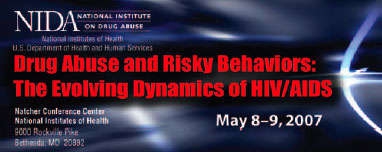More than 400 researchers and clinicians gathered in Bethesda, Maryland, May 8-9 to discuss the impact of drug abuse on the spread of HIV. NIDA sponsored the meeting in collaboration with other National Institutes of Health agencies and the Centers for Disease Control and Prevention.
Drug and alcohol abuse can prompt poor judgment and actions that people might not engage in otherwise, for example, risky sexual behaviors with infected partners. Drug abuse also may increase HIV transmission when abusers trade sex for drugs or money. The increased risk of HIV related to drug abuse extends beyond the sharing of drug injection equipment to include such risky behaviors.
Dr. Igor Grant of the University of California, San Diego, addressed methamphetamine abuse and HIV. The drug and the infection each cause degenerative brain disease. They may damage neural tissue through a common biological pathway—for example, enhanced inflammatory responses—but also seem to generate distinct pathologies that may combine to exacerbate each other. The resulting cognitive impairments may explain why methamphetamine abuse reduces adherence to HIV medications, that, in turn, may facilitate HIV transmission.
Dr. Jonathan M. Ellen of the Johns Hopkins University School of Medicine linked marijuana abuse with risky sexual behavior among African-American youth in San Francisco. Another study indicated that HIV-infected young women who abuse marijuana are less likely to keep medical appointments. Dr. Richard A. Rawson of the University of California, Los Angeles, reported preliminary results suggesting that addiction treatment reduced risky sexual behaviors among methamphetamine abusers—adding to similar findings among methamphetamine-abusing men who have sex with men (see "Treatment Curbs Methamphetamine Abuse Among Gay and Bisexual Men (Archives)"). Similarly, Dr. Kenzie L. Preston of NIDA's Intramural Research Program reported that adding behavioral therapy to methadone maintenance treatment can reduce risky behaviors among outpatients addicted to heroin and cocaine.
NIDA-funded research on the link between drug abuse and HIV infection extends to the international community. Dr. Steffanie A. Strathdee, an infectious disease epidemiologist at the University of California, San Diego, reported that HIV infection among injection drug users has risen sharply in many countries—including the Ukraine, the Russian Federation, Vietnam, Iran, and China—with emerging epidemics in other nations. Interventions that reduce risky behaviors among populations that interact with both high- and low-risk individuals (for example, prisoners, non-injecting drug users, and sex workers who inject drugs) are important opportunities for HIV prevention.
Participants also discussed the disproportionate burden of HIV/AIDS among people in prisons and jails and the importance of interventions in such settings. Improved technology now allows for faster HIV testing, and expanded testing and counseling are key components of prevention strategies for drug abusers and other groups.

